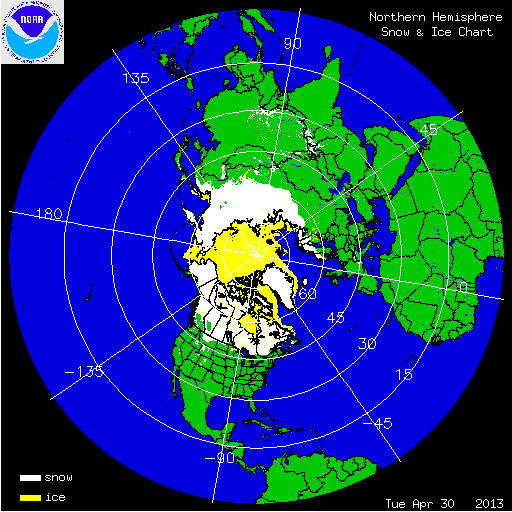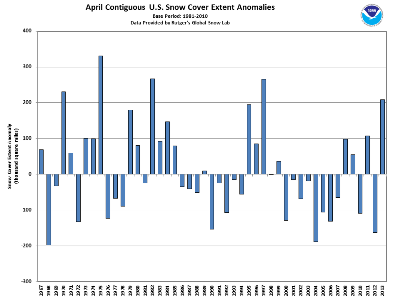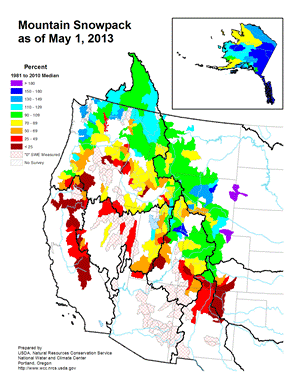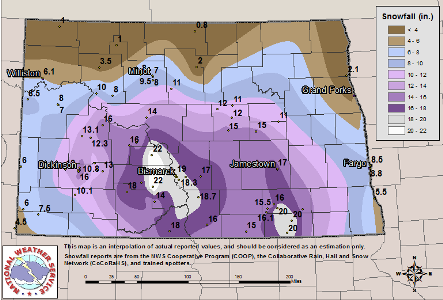During April, the north-central U.S. was cooler and wetter than normal. These conditions were associated with above average snowfall from the Front Range of the Rockies, through the Northern Plains, and into the Upper Midwest. The Northeast and West Coast were warmer and drier than average, limiting snowfall in those locations. According to NOAA’s National Snow Analysis, at the beginning of April, 16.6 percent of the contiguous U.S. had snow on the ground — the high elevations of the West, the Northern Plains, Upper Midwest, andd parts of the Northeast. By April 30th, the snow cover foot print shrank to 5.0 percent of the contiguous U.S. with snow cover present in the Rocky Mountains, the Cascades, and the far western Great Lakes region.
According to data from the Rutgers Global Snow Lab, the monthly snow cover extent across the contiguous U.S. during April was 485,000 square miles, 208,000 square miles above the 1981-2010 average. This marked the 5th largest April snow cover extent in the 47-year period of record and the largest since 1997. During the month, above-average snow cover was observed across the Northern and Central Plains and the Upper Midwest. Below-average snow cover was present in the Northeast and most of the West.
Western mountain snowpack on May 1st, according to the USDA, was above normal in the Cascades of Oregon and Washington, which has been the case for most of this snow season. Beneficial snow fell across the Central and Northern Rockies, increasing snowpack totals to near normal across northern Colorado and most of Wyoming. This region had been experiencing much below-normal snowpack prior to the April snowfalls. Precipitation largely missed the Sierra Nevada Mountains, the Great Basin, and the Southern Rockies. Snowpack totals were less than 25 percent of normal across parts of California, Oregon, Utah, southern Colorado, and New Mexico. Snowpack this time of year is important for determining the annual water budget for both agriculture and human use in these regions and the low snowpack totals will likely cause issues into the summer season. Most of Alaska had above-average snowpack on May 1st, with the exception of northeastern parts of the state and the Alaskan Peninsula. Eastern regions of the state had snowpack totals greater than 150 percent of normal.
Summary of Notable Snow Events:
A very active storm pattern, from the Central Rockies through the Northern Plains and into the Midwest, in combination with colder-than-average conditions, resulted in record snowfall totals during April. The two largest storms hit on April 9th–12th and April 13th–15th. The first storm system dropped heavy snowfall from Colorado to South Dakota. Rapid City, South Dakota received 22.4 inches of snow — the second most for any April storm — and the 15 inches that fell on the 9th was the third highest single-day snowfall on record for the city. Areas just west of Denver, Colorado received nearly 2 feet of snow, and hundreds of flights were cancelled at Denver International Airport. The second storm, on the 13th–15th, hit the Northern Plains. In Bismarck, North Dakota 17.3 inches of snow fell on the 14th, breaking the record for most snowfall on any calendar day. All 350 miles of Interstate 94 passing through North Dakota were closed, as well as a large portion of the same highway in Minnesota.
Select April snow records
- Duluth, Minnesota: April snow total of 50.8 inches marked snowiest month of any month on record.
- Rapid City, South Dakota: April snow total of 43.1 inches marked snowiest month of any month on record.
- Pierre, South Dakota: April snow total of 20.8 inches, most on record for April.
- Twin Cities, Minnesota: April snow total of 17.9 inches marked 3rd snowiest April on record.
- Fargo, North Dakota: April snowfall total of 16.7 inches was the most monthly snowfall this winter season and 4th snowiest April on record.
- Bismarck, North Dakota:
- April 14th snowfall (17.3 inches) record snowfall for any date.
- April 2013 monthly snowfall of 21.8 inches marked snowiest April on record.
 NOAA's National Centers for Environmental Information
NOAA's National Centers for Environmental Information




